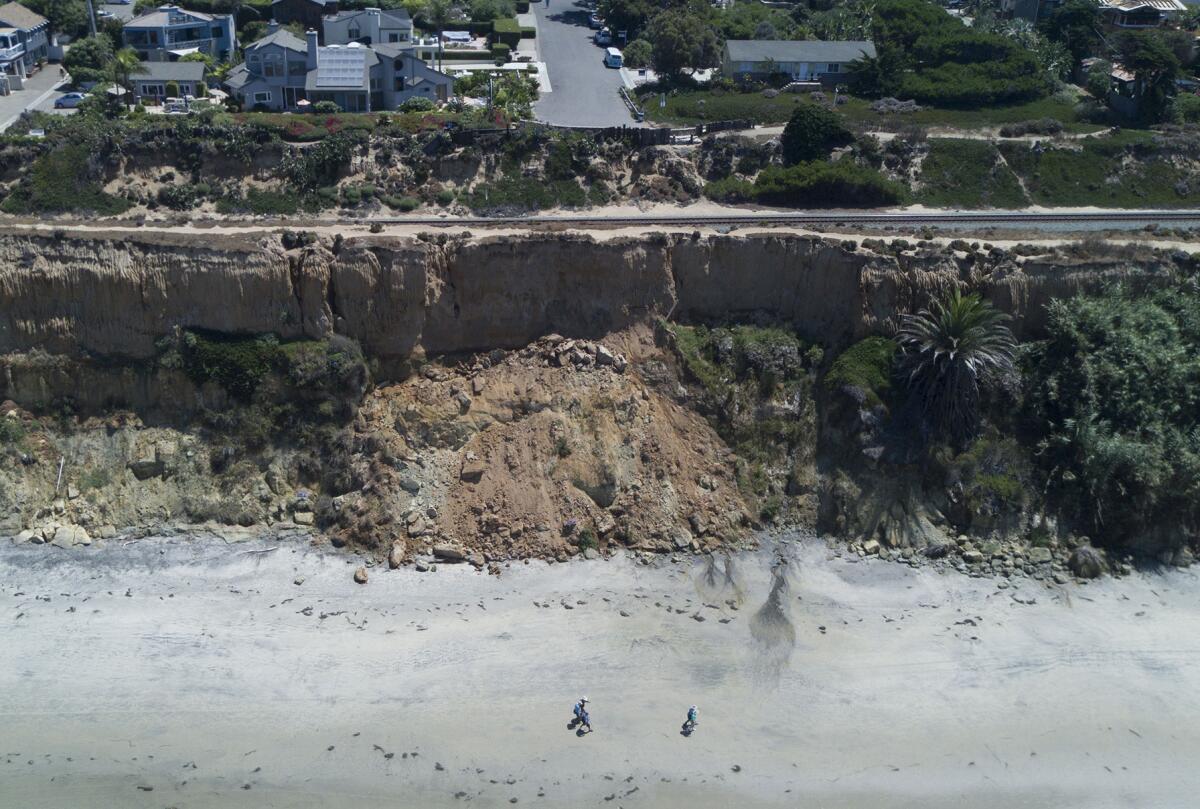We can’t hold back rising oceans. We can only move out of the way

- Share via
Shoreline erosion and coastal retreat have become global issues and an increasing challenge for California’s coastal cities and counties. In part that’s because of the state’s concentrated coastal population, but it’s also because of our coastal-dependent economy and intensive shoreline development.
Failure of coastal cliffs and bluffs, narrowing and loss of beaches, and damage to both private development and public infrastructure are common news stories during major El Niño winters and when large waves coincide with very high tides. In the short to intermediate term (perhaps until 2050), these events will be quite damaging, but over the longer term, sea level rise will become the dominant threat.
We need to do everything we can to reduce our greenhouse gas emissions and transition to renewable sources of energy, but this is going to take some time since 79% of U.S. energy still comes from fossil fuels. We have made a modest reduction in our total carbon dioxide emissions since they peaked in 2007, but China, the U.S. and India, the largest emitters, still contribute about 50% of the global total.
What has become clear is that even if we aggressively move away from fossil fuels, sea-level rise is going to continue for centuries because greenhouse gases are already baked into the atmosphere. So we need to focus on ways to adapt to the increasing rate of sea level rise. This starts with identifying areas subject to current and future coastal flooding and shoreline erosion, and at the community level, coming to agreement on how to respond. We don’t get to vote on whether this is necessary — the crisis is happening now.
In California, old approaches won’t work and have made shoreline conditions worse. Historically, the response to rising seawater has largely been to put in hard structures like seawalls and riprap revetments. An astonishing 38% of California’s four southernmost coastal counties (San Diego, Orange, Los Angeles and Ventura) have been armored in this way.
One of the effects of coastal armoring is the loss of beaches in front of these hard structures. Since the shoreline can no longer retreat naturally, over time the beaches become flooded or drowned. This passive erosion is likely to lead to the loss of 31% to 67% of Southern California beaches by 2100 under sea-level-rise scenarios of 34 to 78 inches, according to the U.S. Geological Survey. The California Coastal Commission has been trying to reduce this threat by prohibiting the building of new seawalls and revetments, with the exception of protecting structures built before the 1976 Coastal Act.
Adding sand to beaches is another tactic that could temporarily forestall shoreline erosion, but it has limitations and high costs. Though large amounts of sand were added to the beaches of Santa Monica Bay and several other Southern California shorelines decades ago, little of this is done now.
Two large beach replenishment projects were carried out along the San Diego County shoreline, one in 2001 and one in 2012, where a total of 3.4 million cubic yards of sand was dredged from offshore sites and placed on a number of county beaches. The total cost was $46 million. Regular beach surveys, however, showed that most of this sand was gone within a year or two.
Building up natural shorelines has also been used as an alternative to hard structures. The idea is to use habitats — primarily wetlands, coral reefs and mangroves — as buffers against wave attack. This could work well in areas where such habitats flourish. But along California’s 1,100-mile coast, the cold California current is inhospitable to coral reefs or mangroves.
Coastal wetlands and marshes in California could be restored and protected as defense measures, but this would mostly involve low-wave energy bays and estuaries — places like San Francisco Bay. Unfortunately, many of our Southern California estuaries and bays, such as San Diego Bay, Newport Bay, Ballona Wetlands and others, are surrounded by development or infrastructure, and there is a limit to how much future sea level they can accommodate.
The fact is, California’s coastal communities face a challenge of increasing magnitude — and we have no clear agreed-upon solutions.
Some communities and neighborhoods are already experiencing coastal flooding during king tides and periods of large waves. Every coastal city and county in California needs to determine its most vulnerable areas and assets and develop response plans with thresholds for relocation or beginning the process of moving back from the shore. Thresholds could include when sea level reaches a specific elevation, or when a street, neighborhood or home is flooded or damaged a certain number of times during a given period.
These will need to be community-specific decisions, and it’s not too early to start these discussions with the rate of sea level rise accelerating. Even if we don’t know exactly how high the sea level will be at a specific point in the future, we know that this process will continue. In the long run, there is no effective way to hold back the Pacific Ocean.
Gary Griggs is a distinguished professor of earth and planetary sciences at UC Santa Cruz.
More to Read
A cure for the common opinion
Get thought-provoking perspectives with our weekly newsletter.
You may occasionally receive promotional content from the Los Angeles Times.









